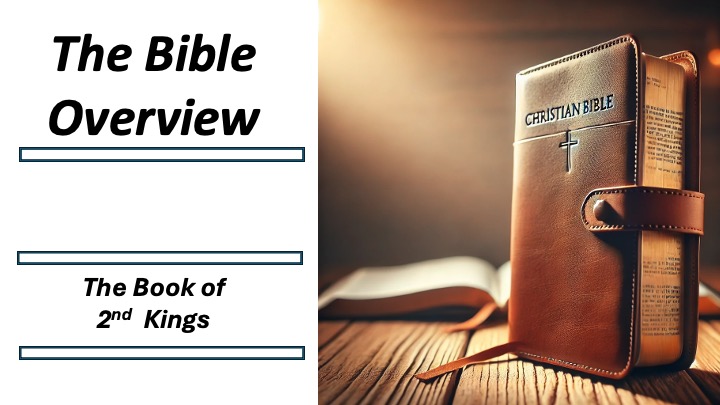Bible Overview 2nd Kings
Mike Ervin

The Overview of 2nd Kings
1. Authorship of 2 Kings
Traditional View
• Attributed to Jeremiah in Jewish tradition.
• No direct author named in the text.
Modern Scholarly View
• Part of the Deuteronomistic History (DtrH) (Deuteronomy–2 Kings).
• Likely compiled by scribes during the Babylonian Exile (6th century BCE).
• Includes earlier sources, such as royal records and prophetic accounts.
2. Date of Authorship
Traditional Dating
• Written shortly after the recorded events (9th–6th centuries BCE).
Modern Scholarly Dating
• Compiled in stages, with a final edition during the Babylonian Exile (c. 550
BCE).
• Some material may date back to the reign of King Josiah (7th century BCE).
3. Intended Audience
• Israelites in exile, reflecting on their history and failure to keep the
covenant.
• Purpose of 2 Kings:
• Explains why Judah and Israel fell.
• Calls for covenant renewal and hope in God’s promises.
4. Major Themes
1. The Fall of Israel and Judah – Both kingdoms collapse due to covenant
disobedience.
2. The Role of Prophets – Elisha, Isaiah, and others warn kings and call for
repentance.
3. Divine Judgment & Mercy – Punishment for sin, but hope remains through
the Davidic covenant.
4. Political & Religious Corruption – Kings lead Israel and Judah into
idolatry, causing national destruction.
5. Chapter Overview (Grouped for Clarity)
A. Elisha’s Ministry (Chapters 1–8)
• Elijah ascends to heaven, Elisha takes his mantle (Ch. 2).
• Miracles: Healing of Naaman, multiplying oil, feeding 100 men.
• Political involvement: Elisha anoints Hazael and Jehu, shaping history.
B. The Rise and Fall of Jehu’s Dynasty (Chapters 9–10)
• Jehu’s bloody purge: Kills King Joram, Jezebel, and Ahab’s descendants.
• Destroys Baal worship, but keeps idolatrous calf worship.
C. The Decline of Israel and Assyrian Conquest (Chapters 11–17)
• Israel’s instability: Multiple assassinations and weak leadership.
• Fall of Samaria (722 BCE): Assyria destroys the northern kingdom.
• Explanation: Israel’s sin and rejection of God led to their downfall.
D. The Reforms of Hezekiah & Manasseh’s Apostasy (Chapters 18–21)
• Hezekiah (good king): Trusts God, resists Assyria, and sees miraculous
deliverance.
• Manasseh (evil king): Brings Judah into deep idolatry, sealing its fate.
E. Josiah’s Reforms and the Fall of Jerusalem (Chapters 22–25)
• Josiah (last great king): Rediscovers the Book of the Law, initiates reforms.
• Babylon conquers Judah (586 BCE): Jerusalem and the Temple are destroyed.
• Hope remains: The last king, Jehoiachin, is released from prison, hinting at
restoration.
6. Summary & Application
• God’s judgment is just, but hope remains for those who trust Him.
• Prophets call for repentance—their warnings are relevant today.
• Leadership matters—faithful kings bring blessing, corrupt leaders bring ruin.